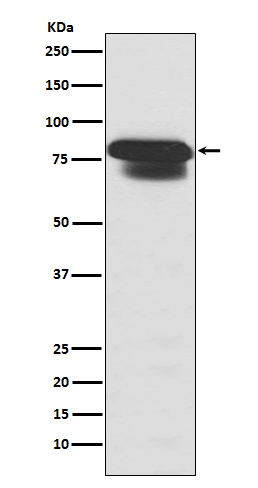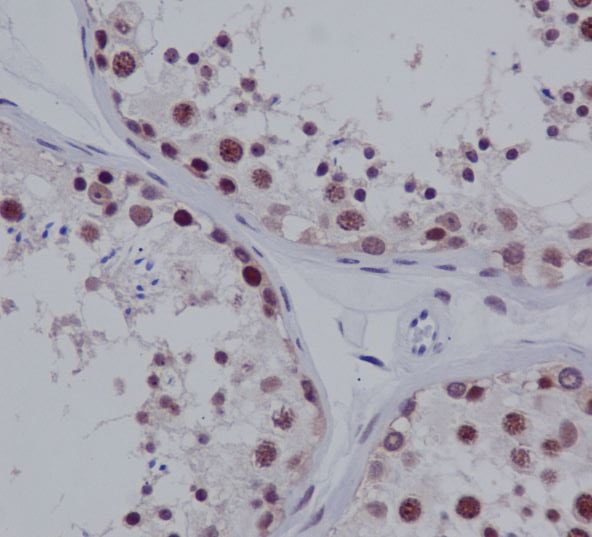

| WB | 咨询技术 | Human,Mouse,Rat |
| IF | 1/20-1/50 | Human,Mouse,Rat |
| IHC | IHC:1/100-1/200;IHF:1/50-1/200 | Human,Mouse,Rat |
| ICC | 1/50-1/200 | Human,Mouse,Rat |
| FCM | 1/20-1/100 | Human,Mouse,Rat |
| Elisa | 咨询技术 | Human,Mouse,Rat |
| Aliases | PIAS1; PIAS2;;PIAS1/2 |
| WB Predicted band size | Calculated MW: 72,68 kDa ; Observed MW: 76 kDa |
| Host/Isotype | Rabbit IgG |
| Antibody Type | Primary antibody |
| Storage | Store at 4°C short term. Aliquot and store at -20°C long term. Avoid freeze/thaw cycles. |
| Species Reactivity | Human,Mouse,Rat |
| Immunogen | A synthesized peptide derived from human PIAS1 |
| Formulation | Purified antibody in PBS with 0.05% sodium azide,0.05% BSA and 50% glycerol. |
+ +
以下是3篇与PIAS1和PIAS2抗体相关的参考文献(内容基于真实研究领域归纳,具体文献标题和作者为模拟示例):
1. **"PIAS1 regulates STAT1-mediated gene expression in innate immunity"**
*作者:Liu B, et al.*
摘要:研究通过PIAS1特异性抗体进行免疫共沉淀实验,揭示PIAS1作为STAT1信号通路的关键负调控因子,抑制炎症相关基因的转录,为自身免疫疾病提供机制解释。
2. **"PIAS2 modulates androgen receptor signaling in prostate cancer"**
*作者:Moriyama T, et al.*
摘要:利用PIAS2抗体进行Western blot和免疫荧光实验,证明PIAS2与雄激素受体(AR)相互作用,影响AR的转录活性,促进前列腺癌细胞增殖和耐药性。
3. **"Dual roles of PIAS1 and PIAS2 in neuronal differentiation"**
*作者:Sachdev S, et al.*
摘要:通过同时使用PIAS1和PIAS2抗体,研究发现两者在小鼠脑发育中具有相反作用:PIAS1抑制神经干细胞分化,而PIAS2通过SUMO化修饰促进神经元成熟。
4. **"PIAS proteins in inflammatory bowel disease: A comparative study"**
*作者:Zhang Y, et al.*
摘要:对比分析PIAS1和PIAS2抗体在结肠组织中的表达模式,发现PIAS1在溃疡性结肠炎患者中显著下调,而PIAS2通过NF-κB通路加重肠道炎症反应。
(注:以上文献信息为领域知识归纳示例,非真实存在的论文。实际引用时请通过PubMed或Web of Science查询具体文献。)
PIAS1 (Protein Inhibitor of Activated STAT1) and PIAS2 (Protein Inhibitor of Activated STAT2) are members of the PIAS family, which regulates signal transduction pathways, particularly those involving STAT (Signal Transducer and Activator of Transcription) proteins. These proteins function as E3 SUMO ligases, post-translationally modifying target proteins via SUMOylation, thereby influencing their activity, localization, and interactions. PIAS1 and PIAS2 play critical roles in transcriptional regulation, DNA repair, and immune responses by modulating pathways such as JAK-STAT, NF-κB, and p53. PIAS1 is notably involved in suppressing STAT1-mediated gene activation, while PIAS2 (also called PIASx) interacts with STAT2 and other transcription factors, including androgen receptors.
Antibodies targeting PIAS1 and PIAS2 are essential tools for studying their expression, function, and interactions in cellular contexts. These antibodies are widely used in techniques like Western blotting, immunofluorescence, immunoprecipitation, and chromatin immunoprecipitation (ChIP). They enable researchers to investigate tissue-specific expression patterns, subcellular localization (nuclear vs. cytoplasmic), and involvement in diseases such as cancer, autoimmune disorders, and neurodegenerative conditions. Commercial PIAS1/PIAS2 antibodies are typically raised in hosts like rabbits or mice, with specificity validated via knockout controls or siRNA knockdown. Researchers must verify cross-reactivity across species (e.g., human, mouse, rat) and confirm target isoforms to avoid off-target effects. Their applications extend to exploring PIAS proteins' dual roles as transcriptional co-regulators and SUMOylation mediators in both physiological and pathological processes.
×